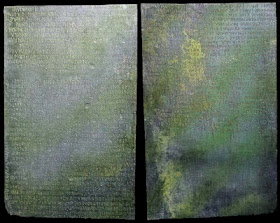Gubbio, founded by the Umbri, is a stunning Medieval hilltown in Northern Umbria that holds the famous Eugubine Tablets, seven bronze slabs that survived from the ancient city of Iguvium. Engraved in the 2nd century BC, the tablets were discovered by a farmer in 1444 who later sold them for two years of grazing rights, having no idea of how valuable they'd be to historians. The tablets are written in the local language of the time, the only documents of this ancient culture which has come down to us in a complete state, and underscore the importance of Gubbio as one, if not the most important political and religious centres of ancient Umbria, providing crucial evidence of the life of the region before Roman times.
Gubbio's superb Palazzo dei Consoli which houses the Eugubine Tablets
Housed in the impressive Palazza dei Popolo overlooking the Piazza Grande within the walled city of Gubbio, the building is an incredible example of Gothic architecture and holds the astounding Museo and Pinoteca Civico — custodian of the Tablets as well as an extraordinary collection of paintings, frescoes, ceramica and artifacts from Gubbio over the centuries.
Two of the seven Eugubine Tablets written in the Umbrian alphabet with elements of the
Etruscan language, with two others written in Latin
One of the most impressive Museums in Umbria, with the exception of the Museo Archeologico Nazionale dell'Umbria in Perugia, the Pinoteca in the stunning Palazzo dei Consoli defines the skyline of Gubbio, with the views from the upper loggia over the valley a breathtaking sight.
View over Gubbio's Piazza Grande from the upper loggia of the Palazzo
View over Gubbio through the bars of the Medieval Palazzo
Upper loggia of the Palazzo dei Consoli with fabulous views in tutti direzione
View over the rooftops of the walled city of Gubbio
View to the south over Piazza Quaranta Martiri and Church of San Francesco
From Piazza Grande, Via Galleotti climbs in a series of steep inclines to the Duomo at the top of Gubbio. Founded in 1229, the rather austere looking Duomo has an impressive interior with a stone wagon vault, a specialty of the region, and some beautiful paintings and frescoes by local well known artists of the time.
The Duomo in Gubbio
The beautiful interior in contrast to the Duomo's simple facade
The walk back down from the Duomo, along Gubbio's steep cobblestone streets, was made all the more inviting knowing that we were about the have the best meal during our two weeks in Umbria, at the Taverna del Lupo. Run by the Mencarelli family, this excellent restaurant set in a series of Medieval dining rooms, considered to be one of the best restaurants in Umbria, it was an unexpected and thoroughly delicious experience.
Taverna Del Lupo on Gubbio's Via Ansidei
The barrel-vaulted medieval interior of Taverna del Lupo
Taverna del Lupo's menu featuring traditional Umbrian dishes,
exquisitely prepared by Lupo's chef Claudio Ranacci
Taverna del Lupo's menu featured such an inspiring selection of traditional Umbrian dishes that we chose a fine Arnaldo-Caprai Montefalco 2008 to compliment the incredible meal we were about to enjoy.
The delicious 2008 Umbrian Montefalco by Arnaldo-Caprai
We decided to fully embrace the exceptional quality of Taverna del Lupo's cuisine and chose to revolve our meal around a Bistecca di Chianna alla Griglia, a specialty of the region and one of the premier cuts of beef in Italy, and is generally served in portions large enough for two people to share, which is what we decided to do. To start our lunch we selected the Delizie Tipiche della Taverna, a parade of five plates of appetizers typical of the region, that were simply outstanding.
The amuse-bouch — a slice of Prosciutto on a crisp fried chickpea crespelle
Mixed Salad with shaved game hen, mushrooms, courgettes and parmigiano
on a bed of wild arugula
Warm Castelluccio lentils on crostini with prosciutto and olive oil
Sautéed porcini mushrooms served on puff pastry with shaved parmigiana
The final of the five appetizers — luxurious scrambled eggs with shaved white truffles
and topped with fresh parmigiana cheese
The owner of the restaurant wheeled the Fiorentine Bistecca di Chianna over to our table and hand carved the steak, and then added a discrete swirl of olive oil to finish the dish
The Bistecca di Chianna alla Grigla, hand carved and presented with a swirl of olive oil
A selection of salts to garnish the beef, including the exceptional black Sale di Nero from Florence
Sautéed spinach and kale
Artichoke flan
A simple but perfect Macchiato ended the meal with a plate of homemade Biscotti
A plate of homemade Biscotti and Amoretti biscuits to end our incredible meal
After our fabulous meal, the owners of Taverna del Lupo proudly showed me around the numerous Medieval rooms that make up the restaurant, with some architectural details dating back to the 1300s. I was even given a tour of the kitchen and was introduced to the chef. Although they all only spoke Italian, the owners carried on with abandon, like I understood every word — which I did in a way. Their obvious pride in their superb cuisine, beautiful restaurant and gorgeous city is a language that's universal. Much the same way our big smiles and heartfelt thanks was understood as we waved goodbye, and stumbled back to our car in a gastronomic haze.




























No comments:
Post a Comment